 |
| |
|
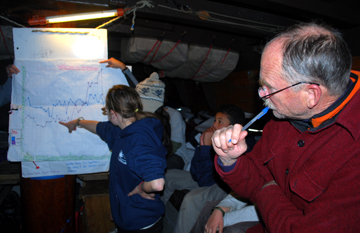
The final phase of the student projects was, of course, the presentation itself. The students spent the afternoon of Day Six graphing the data they had collected and preparing written reports on their materials, methods, and conclusions to accompany their oral presentations. Each presentation was also accompanied by a round of questions, in which the students considered possible sources of error and ways these experiments could be improved in the future.
|
Presentation Project Topics |
|
|
|
|
|
|
In the end, some students were able to support their theories, and in some cases the data produced results the students had not expected. But in every case, the students ended their Voyage of Discovery with a greater understanding of the natural world around them. Suffice to say, each research team impressed their senior advisor with the quality of their work.
You can scroll down or use the links to jump directly to a section.
|
Research Team 1: Celestial Tracking
|
| 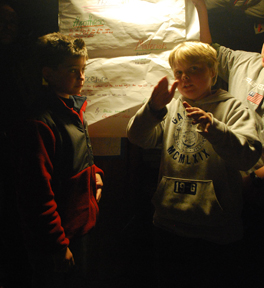 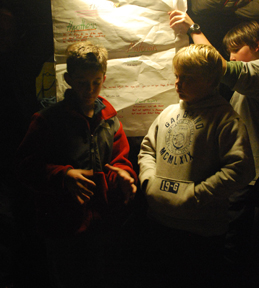
Students: Ben & Brandon
Senior Crew Advisor: Erik Berg
Hypothesis: We believe that the angle of the Sun will in the morning will mirror that in the afternoon, but the bearings will be completely opposite.
Materials: Quadrant, directional compass, clock.
Conclusion: Ben and Brandon started with a strong grasp of what to expect from their celestial tracking experiment. Although dense cloud cover throughout the morning prevented them from testing their hypothesis directly, they were able to use the smooth movement of the Sun throughout the afternoon to extrapolate the missing data. They demonstrated their results well, and by pinpointing the Sun's zenith, they were able to determine the time of true noon and the bearing of true south.
Back to Top
|
Research Team 2: Statistical Analysis
|
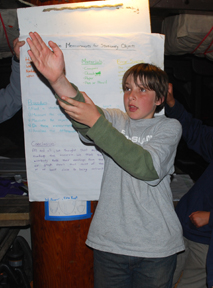 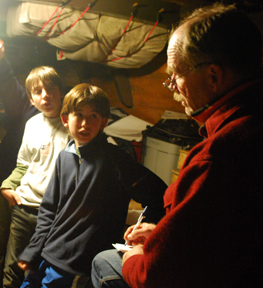
Students: Dante & Erin
Senior Crew Advisor: Kipp Van Aken
Hypothesis: We predict that the crew's readings will fall within a margin of 10 degrees.
Materials: Quadrant, directional compass, Half Moon crew members.
Conclusion: In the end, Dante and Erin's prediction regarding the crew's results proved correct. More importantly, through the process of collecting multiple data sets spread across three days and analyzing the range of results, they learned the difficulty of consistent instrument usage and the importance of collecting multiple data points. They showed a firm understanding of the mean, median, and mode calculations, and their presentation even led to meta-statistical debates, such as the question of which result is more trustworthy: a dozen briefly trained testers reporting one data point, or a highly trained individual reporting a different result?
|
Research Team 3: Comparative Temperatures
|
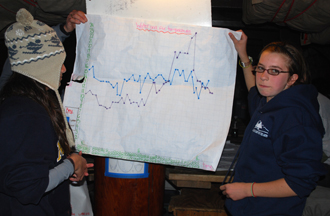 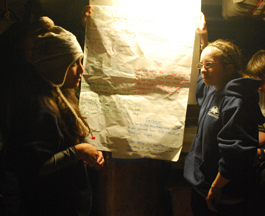
Students: Isabel & Taylor
Senior Crew Advisor: Nico Gans
Hypothesis: The water temperature will be highest in the morning and late at night. The air temperature will be highest from 1130 hours to 1530 hours.
Materials: Digital thermometer, wet thermometer, canvas bucket tied to the rail.
Conclusion: Over the course of their experiment, Izzy and Taylor proved most diligent in collecting their data, and in the process, taught themselves methods of avoiding user or instrument error. They were able to support their hypothesis regarding air temperature, and although their data did not support their theory regarding water temperature, the work did suggest an alternative explanation. Their hypothesis had been based on their personal, empirical experiences, but rather than the water temperature actually rising at night, the data suggested that during nighttime swims, the water -- which maintains a comparatively consistent temperature -- simply feels warmer in comparison to the steeply colder night air.
Back to Top
|
Research Team 4: Salinity |
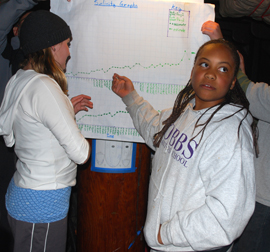 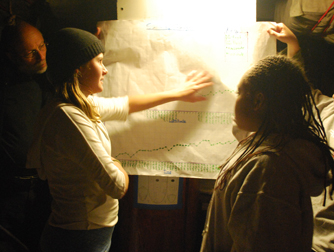
Students: Isis & Sofia
Senior Crew Advisor: Marion Bruijn
Hypothesis: We hypothesize that as we move farther south the salinity level will increase.
Materials: Refractometer, eyedropper, distilled water, canvas bucket tied to the rail.
Conclusion: After a few initial hurdles, in which Isis and Sofia were still learning to properly calibrate their instruments, they were able to consistently track the rising salinity gradient of the Hudson River as we moved from Newburgh Bay to Raritan Bay, strongly supporting their hypothesis. In addition, as they analyzed their data, their readings showed that although New York Harbor is a marine environment, even there the water has not yet reached the full salinity levels typically found in the open ocean.
Back to Top
|
Research Team 5: Current Patterns
|
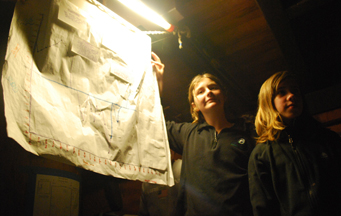 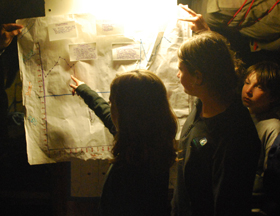
Students: Abigail & Grace
Senior Crew Advisor: Kees Collens
Hypothesis: We think that both the speed and direction of the current will change over time.
Materials: Wooden biscuits, apple peels, banana peels, stopwatch.
Conclusion: While recording the current speed of the Kill Van Kull, Abigail and Grace shopwed a strong grasp of the outcome they expected from the work. Indeed, their data did support their hypothesis as the current shifted directions several times during the full tidal cycle covered in their work. They also demonstrated an awareness of instrument error, seeking to use a single type of floation marker (ultimately relying on heavy banana peels to avoid wind interference) throughout the experiment rather than risk affecting their results by changing instruments midstream, so to speak.
Back to Top
|
Research Team 6: Height of Tide
|
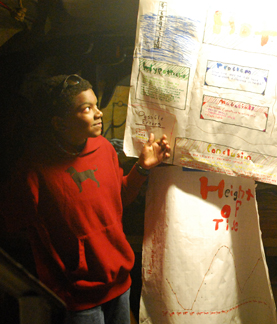 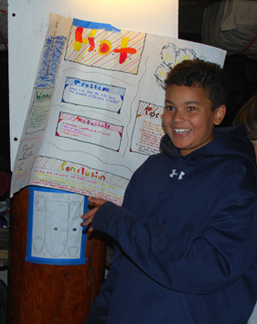
Students: Jason & Matt
Senior Crew Advisor: Rachel Laufer
Hypothesis: We hypothesize that there will be stronger currents later in the day, and that higher tides will accompany these stronger currents.
Materials: Flashlight, depth measurement board.
Conclusion: Jason and Matt sounded the Kill Van Kull at a fixed location throughout an entire tidal cycle. They demonstrated a clear understanding of the purpose of their work, and their data did partially support their hypothesis -- the highest tides they recorded came during the middle of the night, though it was agreed that a broader data set, collected over a longer period of time, would be needed to further analyze this correlation. (Was the moon rising near that time a factor?)
|
|
|
|
|
|



